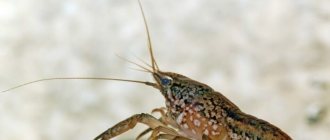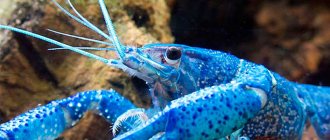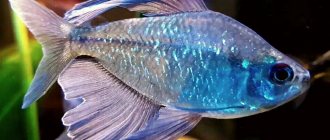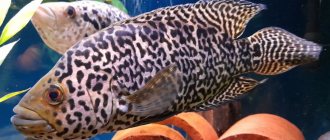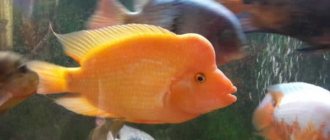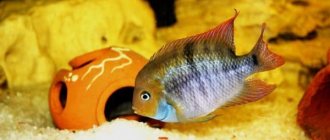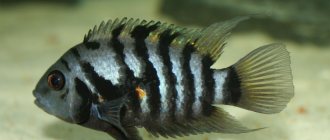Diamond cichlid (lat. Herichthys cyanoguttatus, formerly Cichlasoma cyanoguttatum) is a fairly large, beautiful, but at the same time quite aggressive cichlid. In nature, it lives in the rivers of Texas (for example, the Rio Grande) and northern Mexico. This fish is often confused with another species - Geophagus brasiliensis, but these are two different fish and Geophagus is better known as pearl cichlasoma.
The Diamond Cichlid is one of the aggressive and large cichlids, somewhat similar to the Managuan Cichlid. It reaches 30 cm in length, which is larger than the average size of African and many American cichlids. But in an aquarium it is usually smaller, about 20 cm.
Despite its violent temperament, territoriality and size, cichlid has many fans among aquarists. They are captivated by the fact that this is one of the most richly colored cichlids, and they proudly display it in their large species aquariums.
They have typical cichlid behavior, that is, they dig the soil, carry stones and gravel, and pull out plants. This is a very smart fish that recognizes the owner and looks through the front window when he approaches.
One of the advantages of diamond cichlases is that they are very easy to breed.
However, they are extremely territorial, aggressive, and cannot stand it when someone encroaches on their territory. They attack plants, decor, aquarium equipment, even the owner's hand, so the best thing is to keep them separately, without plants and delicate equipment.
Description
The fish has a powerful body, slightly oval in shape. The frontal part of the large head forms a concave line. In nature it grows up to 30 cm, in captivity its size does not exceed 20 cm.
Appearance
The original coloring is the main pride of the Texas cichlid . The dark brown “dress” of the fish is strewn with sparkling spots of green and blue, creating a diamond effect.
The decor of the outfit does not end there. On the sides there are barely visible transverse dark lines. Along the upper part of the body, from the tail to the head, there is a dotted line of black spots.
The finishing touch is two large black spots, one in the center of the body, the other at the tail.
Among the hybrid species, the brilliant red cichlid (Red Texas) and Flower Horn are especially beautiful.
Nuances of behavior
Cichlazoma diamond short-bodied is in perpetual motion . She actively scours the aquarium, plows up the soil, looks for someone to fight, and quickly crosses the pond from wall to wall.
If she doesn't like some decoration, she will turn it over or break it.
The aggressiveness of the fish is rated at 6–7 points on a ten-point scale.
can fight not only . Eats food with excitement, scattering pieces of food throughout the aquarium.
The owners claim that their pets have high intelligence. The fish quickly get used to the feeding hand and know their owner well.
Lifespan
Diamond cichlises are real long-livers in the aquarium world.
By creating the most comfortable conditions and carefully monitoring the condition of your pets, you can enjoy their life in the aquarium for 15–17 years.
Habitat in nature
Diamond or pearl cichlasoma was first described in 1854. It lives in North America, where it is found in the rivers and lakes of Texas and northern Mexico.
This is the only naturally occurring cichlid that lives in the United States without being introduced or acclimatized. Now its range has expanded, and in addition to Texas, it also lives in Florida and in the Verde River in the La Media Luna region of Mexico.
It prefers warm places in lakes and rivers, where it hides among plants and digs in sandy soil in search of food. Food includes fish, larvae, insects, and plants.
Underwater shooting in nature:
Compatibility
Aggressiveness in character manifests itself at an early age and persists throughout life. Small species of fish and shrimp serve as food for them .
One married couple never quarrels. If several pairs live in an aquarium, fights are inevitable.
Neighbors for diamond cichlases can be:
- black-striped, turquoise cichlids;
- meeka;
- astronotuses;
- arowanas;
- brocade catfish;
- giant gouramis.
These species are not inferior to them in size and can fend for themselves; in addition, good compatibility with Malawians is explained by similar conditions of detention.
Attention! To prevent clashes, the aquarium should be spacious.
Sexual Dimorphism
The female Pearl Cichlazoma has a black spot on the dorsal fin, usually larger and darker than that of the male. Males are usually much larger and more powerful than females. They have a higher body shape; in adult males, a pronounced frontal outgrowth is formed. In addition, males usually have longer dorsal and anal fins.
They reach sexual maturity at about 8 months or at 10 cm in size.
Aquarium
One fish requires 100 liters of water. Based on this (and taking into account their behavior), a couple will have to set up an aquarium with a volume of 250–300 liters and a length of 1–1.3 meters.
It must be equipped with a strong lid.
Water parameters
The body of North American cichlids is well adapted to changes in the environment . Seasonal temperature fluctuations in their habitats are 20 degrees.
When kept at home, fish need only 23…26 °C. The limits of water hardness are 8–20 dH, acidity is within 6.5–8 pH.
Lighting
For fish that spend a lot of time in the middle and bottom layers of reservoirs, a moderate lighting regime is preferable. However, lack of light causes the color to fade .
The best way to light an aquarium is with LED lights built into the lid. Daylight hours are 10–12 hours.
Filtration and aeration
The activity of cichlids is off the charts; they constantly stir up and stir up the water. The accelerated metabolism of fish leads to clogging of the aquarium with the products of their vital activity.
When choosing a filter and compressor, pay attention to the power of the device: the higher it is, the better.
The filter must be combined to carry out mechanical and chemical water purification.
The first component of the device removes suspended matter and dirt, the second purifies the water from ammonia and nitrates.
Attention! With excess nitrates and ammonia in the water, cichlazomas develop ascites.
To saturate a large volume of water with oxygen, a pump compressor is required. The device is noisy, so for night operation it is worth purchasing an additional piezo compressor.
Priming
Pebbles, granite chips, medium-sized decorative stones - these are the soil options for an aquarium with these restless pets.
If you put sand on the bottom, turbidity will constantly float in the water. Cichlizomas like to rummage through it, and they are not at all concerned about the aesthetic problems of the owner.
The preferred color scheme is black and dark blue shades. Against their background, the pearl “chainmail” of cichlids looks especially impressive.
Plants
In a large aquarium with large fish, algae with the same impressive size should grow: wavy bushes of aponogeton and strong anubias, luxurious rosettes of crinum, fluffy twigs of bolbitis .
The main thing is that all of them are not planted in the ground, but in separate vases with weights, otherwise cichlids will dig them up and scatter them around the aquarium.
Scenery
There is no point in filling the space with a lot of decorations. Cichlids love space where they can move freely.
For one fish, place 1-2 grottoes or houses of the appropriate size.
Place a fancy piece of driftwood, add a plant with wide leaves to it - you will get a beautiful and pet-friendly green island.
Breeding
This species is capable of crossing with other varieties (severum, Eliot, leopard, etc.) . Thanks to these breeding features, diamond cichlazoma disc, red, blue, green, eight-banded, and balloon appeared.
Red Diamond Cichlazoma is a hybrid.
Cichlids can reproduce when males grow up to 10 cm, and females 7 cm. This happens approximately in the eleventh month of life. You can stimulate spawning by changing the water and increasing its temperature. During it, males develop a pointed vas deferens, and females are characterized by an ovipositor resembling a truncated pyramid.
Pointed vas deferens of cichlids
It is recommended to organize a separate container for spawning (from 80 l), although it is allowed to leave fish in a common aquarium. Before throwing eggs, females clean the surface - the bottom of the aquarium, a smooth stone, is suitable for this. Diamond cichlazoma lays a lot of eggs, sometimes the number of eggs is measured in the thousands (on average 1500).
Both parents protect future offspring. They dig a special hole where the female will then transfer the hatched larvae. The duration of the incubation period depends on the water temperature - the warmer it is, the faster the eggs ripen. The fry begin to swim around the fifth day.
Diamond cichlid fry with their parent.
Males take care of the offspring. Sometimes they are so protective of the fry that they even beat the females. They may even need to be isolated.
Feeding the fry does not pose any particular problems due to their size. First, you can use Artemia nauplii, then the food should be larger according to the growth of the fish.
Diamond cichlid is an interesting object for aquarium keeping. It attracts with its bright appearance, fairly large size, unpretentiousness to food and other conditions. When getting such a fish, it is important to remember that not all species can get along with it.
Nutrition
Cichlases have a strong body, a lot of muscle mass and an impressive skeleton. To keep it in good shape they need a lot of live protein food.
Bloodworms, shrimp, tubifex, brine shrimp, and crickets are excellent for feeding diamond cichlid.
To replenish your fish's body with vitamins and beneficial microelements, feed them with granulated dry food for cichlids .
Feed your pets once a day. Make sure that portions are eaten quickly and without residue. If overfed, cichlazomas can become obese.
Features of feeding
Keeping cichlids is attractive due to their omnivorous nature. Food for them can be artificial or live , including frozen. To feed adults, you can use tubifex, earthworms, shrimp, bloodworms, and crickets. Large feeds of artificial origin are also suitable for them. Cichlazoma does not disdain various fish, including guppies and neons.
When it comes to dry food, preference should be given to ready-made mixtures for large cichlids.
The result of feeding cichlids is large volumes of garbage. They should be given food in small portions twice a day. Overfeeding should be avoided. When kept in the same aquarium with other fish, timely feeding is especially important, otherwise neighbors may become dinner or an object of aggression.
Mammalian meat should be excluded from the diet. Such products contain too much protein and fat, which is why fish develop obesity and internal organs degrade. Lean meat is allowed in small quantities, which must be finely chopped.
Additionally, cichlids can be given oatmeal and lettuce. This additive must first be scalded with boiling water.
Reproduction
These fish are characterized by monogamy. They, like swans, find a soul mate and are faithful to her all their lives.
If you take juveniles in a school, you will see how by the time they reach puberty they will split into pairs.
Sex differences
Males of the diamond cichlazoma are larger and more brightly colored. Their fins are elongated, while those of females are rounded.
In addition, the male’s forehead is not sloping, but convex, similar to an overgrown mound.
Spawning
A pair ready for reproduction is placed in a pre-prepared spawning tank. You need to place a flat stone or smooth driftwood at its bottom.
The volume of the tank must be at least 90 liters . To stimulate the process you should:
- raise the water temperature by 2–3 degrees;
- Change the water frequently to keep it looking crystal clear;
- feed fish with food high in protein;
- ensure good aeration and filtration in the spawning tank.
Mating games are similar to a fight: the female and male circle around each other, beat their tails and “bite”.
The female’s readiness for spawning is determined by the change in color: in front the body color becomes lighter, and closer to the tail it becomes darker . At this time, the male goes to choose a place for laying.
Having found a suitable pebble or driftwood, he carefully cleans it. Now everything is ready for spawning. The female lays eggs, the male fertilizes them .
Interesting! Spawning of pearl cichlases is not tied to the season; it can occur at any time.
Getting offspring
When the eggs are laid, caring and responsible parents carefully look after them.
Sometimes the male can show aggression, so experienced aquarists advise immediately removing him from the spawning area .
The female monitors the eggs, ventilates them with her fins, and removes dead specimens. At the same time, she digs a small hole.
On the 3rd–6th day, the larvae hatch, and the mother transfers them to the hole.
For 4 days, the larvae simply lie in it, feeding on the substance in the yolk sac.
The next stage, the fry, begins when the yolk sac disappears. Now they can be fed with live dust, brine shrimp eggs and nematode microworms .
Maternal care for the fry lasts until they reach a height of 1 cm. Then the female is removed. Gradually, the juveniles are transferred to regular food, cutting it into small pieces.
They are transferred to a general aquarium when the body length of the fry is equal to the distance from the lips to the gills of the largest male cichlid fish in the aquarium.
Interesting Facts
Despite the fact that diamond cichlasoma has been known for a long time, there is still debate about its Latin name Cichlasoma cyanoguttatum.
In 1983, an ichthyologist from Sweden, Sven Kullander, decided that too many fish, which differ sharply from each other, were classified in the genus Cichlas. On his initiative, a reclassification was carried out and the diamond cichlid began to be called Herichthys cyanoguttatum. Over the years, more than 6 different names were used to designate this fish, of which only two remain in use - Herichthys cyanoguttatus and Herichthys carpintis. Diamond cichlazomas can reproduce quite often - literally every two months. But with frequent spawning, the amount of eggs decreases. Taking this feature into account, producers are given a rest - they lower the temperature of the water in the aquarium.
Some believe that diamond cichlazomas are able to recognize their owner; they watch him through the glass of the aquarium.
Diseases
Fish of this species do not have an innate predisposition to common diseases.
Most problems arise due to poor care and non-compliance with basic parameters.
Let's look at what diseases you can encounter when keeping cichlases.
Ascites (dropsy)
The disease is caused by dirty water. A sick individual refuses food, is afraid of light and moves little.
The problem is aggravated by bulging eyes. Baths with antibiotics are used as a remedy.
Ichthyophthiriasis (“semolina”)
Prolonged exposure to water with a low temperature leads to the appearance of white grains on the body of fish.
To prevent a negative reaction, it is necessary to urgently increase the temperature to a normal value and increase aeration so that the water column quickly warms up.
Dactylogyrosis
Infectious diseases. Parasites penetrate into a body of water with dirty soil or poor quality food .
A sick fish stops eating, gasps for air, and mucus appears on the gills. Adding copper sulfate to the water (0.15 g per 100 liters) helps rid the individual of the parasite.
Lepidorthosis
The main symptom of the disease is scale loss. For treatment, baths are made with streptocide (0.30 g per 20 liters) or biomycin (0.15 g per 10 liters).
Plistophorosis
The infection can be transmitted by already sick fish. Sick individuals lose color , develop large light spots, eat poorly and lose weight.
The use of Nemazol or Fumagelin helps get rid of the infection.
Obesity
Significant weight gain is caused by overfeeding, the use of fatty meat, and monotony of food.
The fish are given fasting days and their diet is balanced.
Notes
Pearl Cichlids are sometimes passed off as Texas Cichlids - a misleading common name often given to Herichthys Carpintis - even though they are a completely different species of fish from the one we know as the Texas Cichlid (Herichthys cyanoguttatus). This is what is commonly called the Green Texas Cichlid.
The two species are very similar in appearance, which often leads to confusion, but their spots differ in size and shape. Herichthys cyanoguttatus has very small, relatively uniform dotted spots, whereas Herpthys carpintis has larger, patchy spots. Moreover, male Texas cichlids do not have a pronounced growth on the frontal part.
Maintenance and care
What to feed
Considering the special structure of the mouth of parrots, food should be chosen correctly and given in crushed form. These fish are fed with gammarus, bloodworms, aulophus, and Tetra granulated food for parrotfish. Homemade minced meat is made from live sea fish and frozen. The main thing is variety: alternate dry food with live bait.
It should be borne in mind that some fish like protein-based food, while others choose plant foods.
Allowed to feed:
- peas;
- zucchini;
- corn;
- bell pepper;
- dandelion;
- lettuce leaves.
In order not to overfeed, otherwise the pets will become fat, food is given fractionally in the morning and in the evening. The remains are removed.
How to maintain natural color
The color of the fish changes over time. This is influenced by the age and conditions in which parrots are kept without artificial coloring. To keep the color bright longer, it is useful to add shrimp to the food, removing the shell, live greens, or purchase specialized food with natural dye.
When caring for budgerigar fish, it is worth knowing that the reason for the color fading is low temperature or bright lighting. And dark soil or the background of the aquarium will help highlight the brightness of the color.
How long do parrot fish live?
Despite artificial changes in aquarium parrots, the fish are able to live up to eight years. Proper care extends the lifespan to 10 years.
Compatibility with other fish
Parrots are considered peace-loving fish, but like all cichlids, they do not get along with strangers, not wanting to share their own territory. Therefore, they are housed with fish of the same size that inhabit other water layers. This is how parrots get along:
- with mossy and Sumatran barbs;
- with cichlids of another species;
- with swordtails;
- with mollies;
- from Congo.
Not against catfish, razorbacks, black knives and arowanas. The main thing is that the aquarium is not crowded, and that the parrots have enough of their own territory and shelters. Cichlids do not like slow-swimming fish, and simply eat shrimp and small fish. Parrots do not get along with angelfish, spotted acaras and some cichlids.

